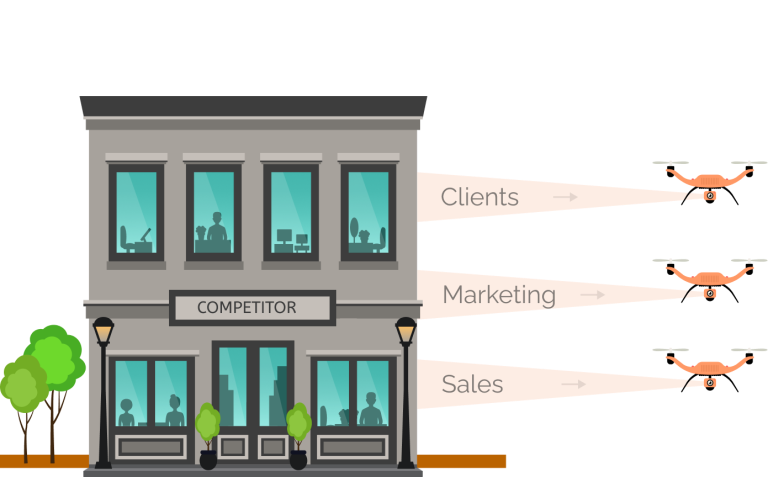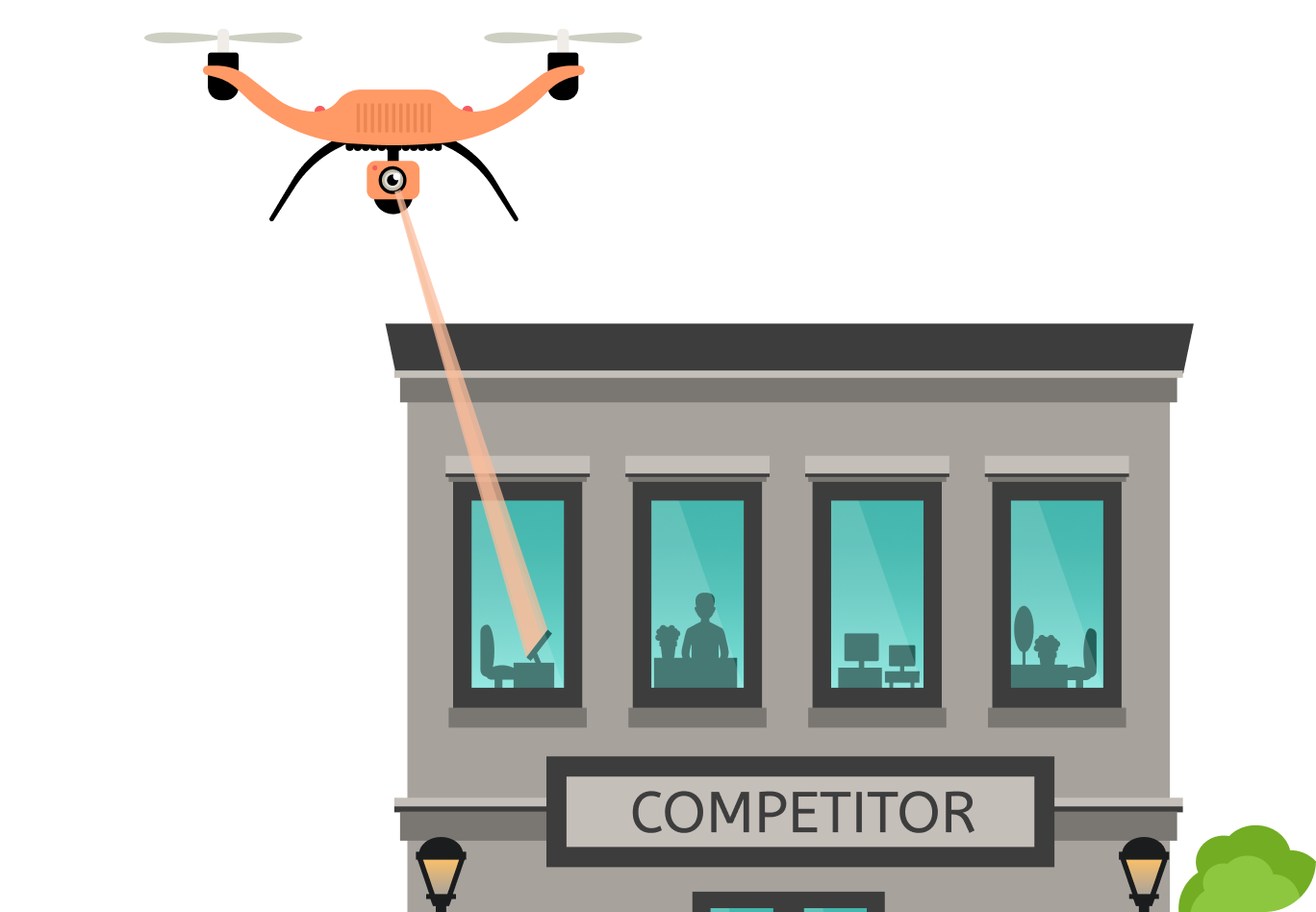Order a competitor analysis and outpace him
Obtain all data on his marketing, sales, and customers. Even the ones he hides. Find out everything about the competitor.

Consider your drone flying over the competitor's office, capturing everything. Where the customers are coming from, how they're being sold to, and what entices them – you know it all.
The combination of artificial and natural intelligence
5 data analytics specialists
11 data retrieval managers
3 neural networks for data analysis
We operate in 44 countries

Obtain figures
on your competitor's
business
We identify the explicit and implicit connections and moves of competitor. And you see data on sales, marketing, and customers.
Suitable for any business aiming to be beyond competition
You'll understand what does or doesn't generate revenue. You'll see what not to do and what to do. Take customers from the competitor. Save time, resources, and money. Earn more.
Competitor's business online
Find out all the important numbers about your competitor. This is an analysis of the site and, in general, the actions of a competitor online.
What data on your competitor are we looking for for you:
Finance
Partnerships
Achievements
Marketing
Statistics
Competitive Edge
Future Directions
Business Model
Data on visits to the website
Visitors from all customer sources
Disadvantages highlighted by employees
Advantages highlighted by employees
Disadvantages highlighted by users
Advantages highlighted by users
€199 per competitor
Competitor's business online + offline
Find out all the important numbers about your competitor. This is an analysis of the site and, in general, the actions of a competitor online + offline.
What data on your competitor are we looking for for you:
Finance
Partnerships
Achievements
Marketing
Statistics
Competitive Edge
Future Directions
Business Model
Data on visits to the website
Visitors from all customer sources
Disadvantages highlighted by employees
Advantages highlighted by employees
Disadvantages highlighted by users
Advantages highlighted by users
Online mystery shopping check
Offline mystery shopping check
Sales process analysis
Sales funnel analysis
€399 per competitor
You'll be able to outpace any competitor
Studying and analyzing how a competitor operates will give insight into where to allocate resources and efforts.


You'll see his business model
To understand his unfair advantages, unique features, and what truly generates his revenue.
Learn what matters to his customers
Identify the strong and weak points of his business and products. Learn what is often criticized and highly valued.


Boost profits through your competitor
He spends money, trying various approaches and methods. You'll take his best practices for yourself. For free.
What is competitor analysis?
Competitor analysis is an integral part of corporate strategy. It involves identifying key competitors and researching their products, sales, and marketing strategies.
This provides you with a comprehensive understanding of your competitors' strengths and weaknesses compared to your own, which is critical for identifying your competitive advantage and strategy.
Analyzing how competitors market their products helps to understand their positioning. For example, Nike might focus on emotional branding and celebrity ambassadors, while Adidas may emphasize product innovation and performance.
Competitor analysis is not just about understanding your competitors, but also about strategically positioning your own business. It aids in making informed decisions regarding product development, marketing strategies, and overall business strategy, ensuring the maintenance of a competitive edge in the market.
What is the purpose of the competitor analysis?
Competitor analysis helps to identify both opportunities and threats in the market.
Strategic decisions, whether about pricing, marketing, product features, or expansion, can be effectively guided through competitor analysis.
Competitor analysis is a critically important aspect of business strategy. This process involves a deep analysis of the operations, strategies, and outcomes of your competitors to understand your own competitive advantage and areas for growth.
Competitor analysis is a multifaceted process that involves identifying competitors, gathering and analyzing data, understanding strategies, and studying their successes and failures. It's not just about keeping up with the competition, but also about identifying unique opportunities for success.
What types of competitor analysis are there?
Comparative analysis.
SWOT-analysis.
Market positioning analysis.
Financial analysis.
Product and service analysis.
Customer analysis.
Digital presence analysis.
Sales and distribution analysis.
Advertising and marketing analysis.
Strategic analysis.
Pricing analysis.
Operational activity analysis.
Technological analysis.
Benchmarking.
In each of these examples, specific types of competitor analysis are used to gain insights into their market position, understand competitor strategies, and identify areas for improvement or differentiation.
Competitor analysis mistakes
Neglecting smaller competitors: However, these smaller companies may be developing disruptive technologies or innovative strategies.
Ignoring indirect competitors: Companies now face competition not only from direct rivals but also from businesses in different sectors offering substitute products or services.
Misunderstanding competitors' strengths: Often, the focus is placed on studying weaknesses. However, examining their strengths can provide valuable insights for developing your own strategy.
Incorrect data interpretation: Misinterpreting competitor data can lead to erroneous strategies.
Lack of continuous analysis: The market is constantly changing, along with competitors' strategies. Regular analysis is necessary to update and keep data current.
“
For example, Samsung continuously monitors its competitors - Apple, Huawei, and Xiaomi. It observes how Apple's focus on design and user experience sets its products apart, how Huawei's investments in research and development expand its market share, and how Xiaomi's aggressive pricing strategy captures the budget market segment.
“
A Crayon survey revealed that companies conducting in- depth competitor analysis are three times more likely to achieve high efficiency. Furthermore, research by the Business Research Company indicates that companies regularly conducting competitor analysis experience, on average, a 10% faster growth rate than those that do not.
“
The small cosmetic brand, GlowBeauty, had plans to expand its product line. However, competitor analysis revealed that similar products from other brands had recently faced failures. This understanding helped GlowBeauty avoid potential losses by reallocating its efforts into more promising product categories.
“
The eco-friendly cleaning product company, GreenClean, analyzed the sales volumes and customer reviews of its competitors, identifying a lack of eco-friendly laundry detergents. They swiftly launched a new product line to fill this gap, capturing a 15% market share in this segment within a year.
“
A manufacturing company like Caterpillar can analyze the production processes of a competitor like John Deere, noting that John Deere's investment in automation has led to a 10% reduction in production costs. This indicates a potential area for profit growth for Caterpillar.
“
Companies' expenditures on digital marketing can reveal their strategic priorities. For instance, in the beauty industry, Estée Lauder allocated 65% of its marketing budget to digital channels in 2023, indicating the importance and profitability of online channels as a source of customer orders.
“
A newcomer in the e-commerce sector, QuickShop, noticed during competitor analysis that none of its competitors offered a reliable same-day delivery service. Capitalizing on this gap, QuickShop introduced an express delivery option, which resulted in a 15% increase in customer numbers within the first 6 months.
“
The cosmetic brand NYX analyzed the customer base of its competitor Maybelline and discovered that Maybelline had a strong and paying audience among women aged 30-44. This provided NYX with a compelling reason to expand its product line, attracting a new age group of customers and resulting in a 12% increase in revenue.
“
For example, when McDonald's noticed the growing trend towards healthy eating, they introduced more salads and fruit options. As a result, salad sales increased by 46%.


